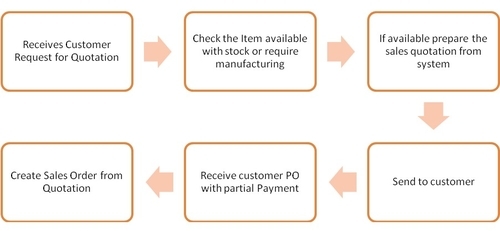A company's business process starts from the customer order, which could be the sales of a product or the manufacturing of a product based on a customer's request. In the case of the sale of a product, they create a sales order for the customer and issue the items from their stock, which results in accounting entries for this transaction in the system, and the update of the on-hand stock. For sales, which are based on a customer request, the company calculates the item cost plus the price to create the customer order and receive a partial payment from the customer. In the manufacturing business, some companies manufacture the material based on the customer request—for example, in the furniture business, the company also manufactures the material based on customer request. After that, a new item code is initiated for the ordered item and then a purchase order is created and sent to the supplier for material delivery. The company purchases the material from fore ign suppliers as well as local suppliers. The supplier payment is made through Telex Transfer (TT) or Letter of Credit (LC). After they receive the material, they issue to Work in Process (WIP) to start manufacturing. Company manufacturing is based on discrete manufacturing; there is no process manufacturing in their current business process. After they finish the manufactured product, they transfer the finished product to the warehouses. Then, the warehouse creates a Good Transfer Note (GTN) and they deliver the finished goods to the showroom has received the customer request for this product. After this, the showroom creates a Good Issue Note (GIN) for the customer, which results in accounting entries in the system.
When the customer requests a product that needs some modifications, the company creates a sales invoice and receives partial or full payment from the customer. Then a new item code is created with a calculated cost for the new item. In order to finish the product for the customer, the company creates a purchase order to the supplier for the required materials. After paying the supplier either through LC or TT, they issue the material to the WIP to begin manufacturing the product. When the finished product is ready, they send it to the showroom and issue the item through GIN to the customer.
 |
The sales order process begins with a customer's request for an item. Then the company creates a sales order and receives partial or full payment. Then they create Local Good Order (LGO) and send it to the warehouse that receives and sends the items and issues the GIN. The showroom receives the items and creates a Good Receipt Note (GRN) for the customer and prints the Customer Statement if requested.
 |
The inter-organizational transfers are done among branches in various countries. An inter-organizational transfer starts with a requesting branch sending an internal purchase order to the other branch. The receiving branch then issues a GIN for the requested items and send this to the requesting branch and a GRN is created.
 |
Whenever the customer rejects the items, the company creates a sales return invoice against the funds returned, and they also create an Item Return Note (IRN) against the returned items.
 |
When the customer requests a quotation, the company verifies if the item is available in their stock or needs some modifications, if it requires modification they calculate the actual cost plus profit margin, and they create the sales quotation that is sent to the customer. After receiving the customer PO, they create the sales order from the quotation.
 |



